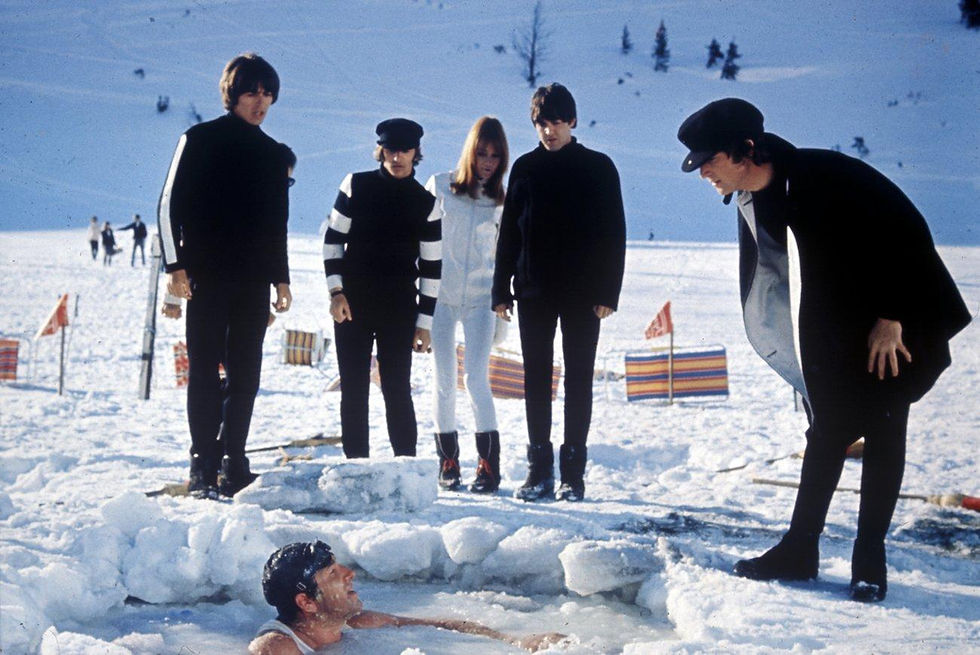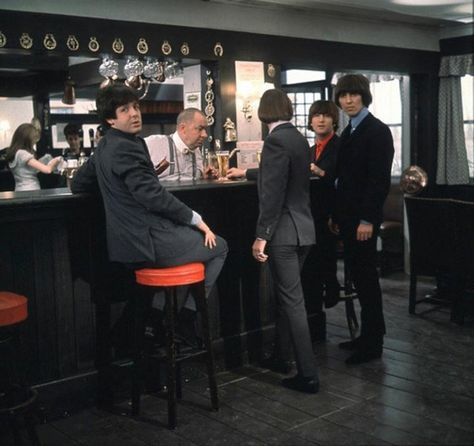Paul Gilroy & Ethnicity + Postcolonialism - HELP!
- Steven Grace

- Oct 18, 2023
- 6 min read
Updated: Nov 3, 2023

HELP! is a 1965 British Comedy starring The Beatles in their 2nd feature-length film, and the first to be filmed in colour. Unlike the day in the life (pun absolutely intended) approach and fictionalised documentary/handheld style of A Hard Days Night that exemplified the joyous charisma of the bands pop sound and their own personalities, HELP! is instead a comedy caper that focuses on the band as they're chased around the world when trying to record new music after an Indian cult try to reclaim a sacrificial ring given to Ringo Starr which is stuck on his finger. Try saying that without laughing at the absurdity of the plot. Chasing them also is an ensemble cast of mad scientists who want the ring for themselves in hopes of becoming rich and famous, and the police who are trying to save the band. However, I think it's clear who and what I'll be focusing on for this theorist blogpost surrounding ethnicity.

Despite being outdated with some of its representations which I'll be exploring further throughout, I still adore this film so much. Whilst it isn't as pioneering and also revolutionary as the bands first film, and is also prone to pacing issues particularly during scenes with long dialogue (a result of the band being mostly high throughout filming), the humour is just as hilarious and mundane, if not even more absurd and ridiculous compared to A Hard Days Night. The film is also gorgeous as well, the colours are really vivid and pop out so vibrantly, and is easily one of the most visually stunning and impressive films I've ever watched. The You're Going To Lose That Girl music sequence oozes with so much maturity and personality and is probably the defining scene of any Beatles film for me. The film also released in 1965 which is easily my favourite year of The Beatles. From the release of their crowning pop album with HELP! and my favourite of not only their LSD transitional albums, but my favourite album of theirs ever with Rubber Soul, and their hairstyles were also my favourite of this era too so maybe I am a bit biased.

Paul Gilroy's Ethnicity and Postcolonialism Theory argues that Britain has an air-brushed version of colonial history, and have failed to mourn the loss of the empire which has influenced politics and attitudes towards non-white people in modern day Britain. His theory also points out that Britain actively celebrates the conflicts against Hitler during WWII because 'standing firm against the Nazis' comforts Brits by making them feel righteous and perennially innocent. Gilroy also argues that we need to understand Britain's colonial history in order to strengthen our contemporary multi-culture as the national identity of this country has constructed itself in a way that views itself and its position to not include blackness; Blackness and Britishness are perceived to be mutually exclusive and always seen as 'other.' Finally, he argues the idea that colonial discourses continue to inform contemporary attitudes to race and ethnicity in the post colonial era. Civilisationism constructs racial hierarchies and sets up binary oppositions based on notions of otherness.

HELP! as already mentioned is a film that follows an Indian cult who realising during a sacrifice to their goddess their sacrificial ring is missing, chase The Beatles around the globe in order to retrieve the ring from Ringo Starr who so happens to be wearing it, or if all fails prepare to sacrifice the drummer instead. These segments of the film are very insensitive even by 1965 standards, and as Gilroy would argue represent these as 'otherness' compared to the band and also Britain, ideally in an attempt of comedy which in a modern context doesn't succeed. A lot of the humour when looking at how these characters are represented as 'otherness' come from a multitude of factors. In general this is in terms of the score that appears whenever the cult are on screen that borrows from a lot of Indian sounding music, making them appear to be different compared to the rest of the cast. There are also the costumes and dim-witted sidekick to the cults leader that make them further appear uncivilised to British society. Alongside the thick, heavy Indian accents that the actors portraying these roles didn't even have and had to exaggerate for what I can only assume was for comedic effect. In fact, a lot of the characters in the film part of the cult, including the leader are portrayed by actors from British and Australian backgrounds which Gilroy would accuse the film of whitewashing. Finally, there is the intentions of the cult and their purpose to serving the narrative and driving it forward which again is to retrieve their sacrificial ring and continue sacrificing members of the cult which represent these characters solely as religious fanatics and nothing more.

One scene that Gilroy would argue serves his points would be the scene when the band and eventually the cult interact through the Indian restaurant, or in other words the British run restaurant that sells food and plays music that comes from this heritage, with white characters dressed up in very Indian clothing. Whilst our 1965 set edition of Vogue reveals a fascination with the 'exotic' and unexplored cultures in western media was evident throughout this era in British society, there is no denying that even from a place of heart and interest that these representations and donning of clothing were of the 'exotic other.' When the cult take over the restaurant, knocking unconscious the chefs, waiters and musicians and taking their clothes to wear for themselves, they are yet again represented as naturally violent and aggressive which further adds to this idea that the national identity of this country and the intent of patriotism further positions blackness and other ethnicities as mutually exclusive to our 'righteous attitudes.' How could I also not mention the guy who lies down on a bed of pins. Again do I need to explain why this is culturally insensitive, the guy literally says immediately "oh that's better." It is ironic however that despite how outdated this scene is, it will forever remain an important part of The Beatles legacy. This is due to the fact that on set, George Harrison first encountered a Sitar and was immediately interested in the instrument. Not only would this go on to shape the musicians religious outlook of life that gave us incredibly wholesome and genius songs like "My Sweet Lord" and "What is Life," but in terms of his time with The Beatles would go on to influence tracks like "Norwegian Wood (this bird has flown)," "Love You Too" and what I personally believe to be their most underrated song, "Within You Without You" and influence what would become of their LSD era of music with Rubber Soul, Revolver and the revolutionary Sgt Peppers.
Whilst I know this blog is about ethnicity and colonialism, I do think it's also worth pointing out the pub scene that features the band and members of the British public joining together in song to Beethoven's 9th Symphony that alongside the mise-en-scene of the pub and the football stadium we ambiguously cut to (this film is weird I told you) just culminates in a scene that's so ridiculously patriotic that I laugh so hard every time this scene comes on whenever I watch it, but something Gilroy would argue points out our celebratory/patriotic status.

However, I would argue that a theorist like Stuart Hall, particularly his Reception Theory would also be worthy of discussing here. This is because audiences would take into the account the representations of the film and in a modern context take either an negotiated or perhaps oppositional reading. In terms of negotiated, some audiences may argue that whilst the film comes from a place of heart and is just as recognisable in being fascinated with other cultures like other media texts and mediums of this era were, nowadays the film would come across as culturally insensitive due to the representation of a lot of non-British characters as exotically different and unnatural to British society. Others may instead take an oppositional reading, and see these representations simply as outdated and racist, since a lot of these characters are one-noted and either religiously strict, or just cold-hearted attempted murderers through their multiple attempts at almost killing The Beatles in many ways.

Overall, Gilroy's theory is perfect nonetheless for exploring the representations of ethnic characters in a film like HELP! As it reveals even in a society that was becoming more intrigued by cultures different from the hegemonic representations of a white civilised society in western media, that a lot of the representations in a modern context simply have aged poorly and reveal how even with progressive attitudes there was still a clear binary between British civilisation and other ethnicities.






Comments